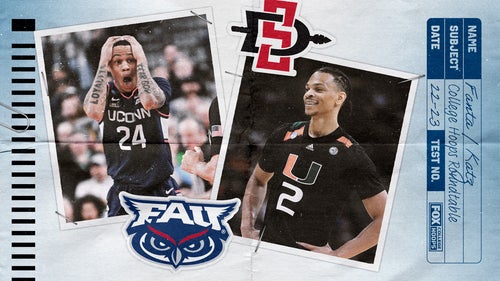The potential hazards of fans storming the court has run smack into a question: How to stop them?
Recent incidents in college basketball have underscored the potential dangers that come from jubilant fans storming the court after the game comes to an end. Finding a solution is proving to be a challenge.
Duke center Kyle Filipowski and Iowa star Caitlin Clark both got caught in scary incidents recently. An Ohio State fan accidentally knocked Clark down after the Buckeyes beat the visiting Hawkeyes and last weekend Filipowski got his right knee banged up in a collision with a Wake Forest fan.
Duke coach Jon Scheyer called for immediate measures from the Atlantic Coast Conference to prevent court storming but stopping such often-impromptu celebrations is easier said than done, especially with most student sections so close to the court in what pretty much everyone believes is one of the unique and beloved things about the sport.
“You can try to do a zero tolerance policy but how are you going to enforce that?” said Brandon Allen, director of research for the National Center for Sports Safety and Security. “And what does that look like?”
Basketball powerhouse Kansas and coach Bill Self have endured court stormings in road losses. Self said he thinks it has gotten better by educating players on how to deal with those situations and getting to the locker room swiftly, but he doesn't like that they have to.
“I mean, calling a timeout with 15 seconds left and it’s a 10-point game to get guys out of the game, or telling them don’t go out there, stand by the sideline,” he said. “But even with that, that should not be the responsibility of the visiting team to educate their guys. I don’t like it.
“I would think the leagues could certainly put stiff enough penalties down on places that do that (to) certainly deter those things from ever happening.”
Some leagues have fines in place and they haven't stopped anything. Allen doesn't think are effective, nor does he like the suggestion from Alabama athletic director Greg Byrne that teams whose fans rush the court forfeit the game. He thinks some schools may have to consider moving student sections farther from the court and pulling season tickets for fans who storm the court.
A simple warning for fans to let visiting teams leave the court before coming down might also help, Allen said.
“In my opinion, there’s going to have to be some kind of consequences for these fans rushing the court and hurting athletes,” he said.
The Southeastern Conference, in addition to six-figure fines that go directly to the visiting schools, has put in new rules requiring more uniform law enforcement protection for teams before, during and after games. Not just security guards.
Jeremy Hammond, an assistant commissioner of the SEC, said there has been an added emphasis on protecting visiting teams and giving them a safe path to the locker rooms.
“In many ways, from a physical security standpoint, it becomes unsafe to try to stop them (fans) if that group decides they’re going to come down,” said Hammond, who headed up a working group that came up with the league’s recent rules updates.
He pointed out that ringing the court with extra security personnel hasn’t really worked. “So we fight the battle that we can and focus more of those resources on the team themselves, helping them get off safely,” Hammond said.
Storming football fields and basketball courts have become a beloved option for fans over time. The Boston Public Library has a photo of fans going after a goal post after the 1940 Harvard-Army game.
In basketball, fans rushed the court after the so-called Game of the Century in 1968 when Houston knocked off UCLA at the Astrodome, the first college hoops game televised coast to coast. Notre Dame fans hit the courts after the Fighting Irish ending UCLA's record 88-game winning streak in 1974.
Kurt Kemper, a history professor at Dakota State, said fans rushed the court at Madison Square Garden in 1950 when City College of New York became the only school to win both the NIT and NCAA tournaments. Kemper, who has written books on college football and basketball, said he has found no video evidence of players back then taunting opposing teams.
“The reductivism and intimacy provided by television and 24/7 media access, often glorifying and exalting devoted hostile student sections (with the Cameron Crazies and K’ville being only the most prominent), has shifted that dynamic to a such that students exhibit little to no sense of transgression,” Kemper wrote in an email, alluding to Duke's home fans.
No coach wants his players or staff in jeopardy. But Marquette coach Shaka Smart said he doesn’t want schools and leagues to overreact, noting the court storming celebrations are an aspect of college sports that create memorable scenes. If they can be done safely.
“Whoever is working in game operations, we just got to make sure that the players are safe, because we don’t want anyone getting hurt,” Smart said. “You look at some of the pictures of like iconic wins with people hanging off goal posts in football or everybody on the court in basketball, so I wouldn’t say a blanket statement you’ve got to get rid of it all.”
___ AP Sports Writers Aaron Beard, Dave Skretta and Steve Megargee contributed to this report.
___
Get poll alerts and updates on AP Top 25 basketball throughout the season. Sign up here. AP college basketball: https://apnews.com/hub/ap-top-25-college-basketball-poll and https://apnews.com/hub/college-basketball


